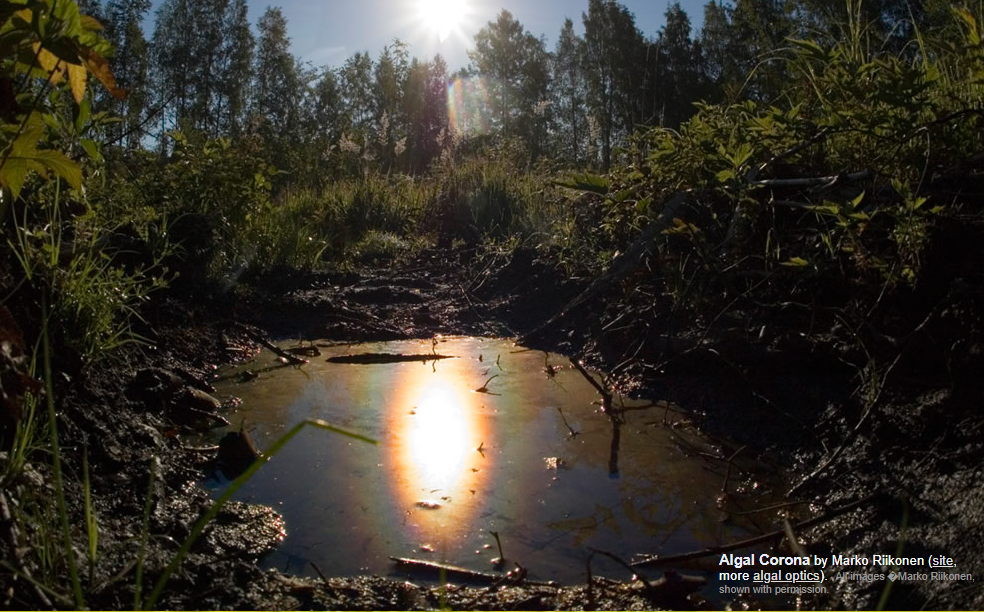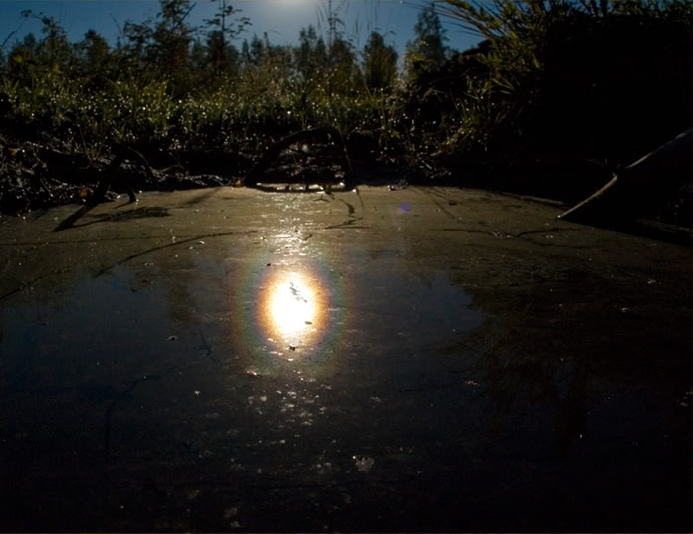On the surface of a pond 1
Exploring the Phenomenon of Algal Coronae on the Surface of a Pond
Have you ever gazed at a pond's surface and been captivated by the stunning play of light and colors? One captivating atmospheric optics phenomenon that can occur on the surface of a pond is known as an algal corona. While we are familiar with coronae formed by cloud and fog droplets, algal coronae offer a unique and intriguing spectacle. In this article, we will delve into the fascinating world of algal coronae and explore the science behind their formation.
Unlike traditional coronae that are formed by transparent and spherical scattering particles, algal coronae demonstrate that particles need not conform to these characteristics. The only requirement for coronae formation is that the scattering particles be small and relatively uniform in size. Algal cells, such as Nautococcus, possess these qualities, making them ideal for creating coronae. These globular cells, ranging in diameter from 7 to 17 microns, float partially submerged on the water's surface, presenting a hemispherical shape for light scattering.
When sunlight reflects upwards from the surface of the pond, it encounters these algal scatterers. The scattered light then converges to form the algal corona. The shape of the corona appears as a vertically elongated ellipse because the algal scatterers themselves have horizontally elongated shapes. As the sun rises higher in the sky, the cells present more circular cross-sections, causing the corona to become increasingly circular as well.
It is interesting to note that Marko Riikonen, who has extensively studied algal scattering phenomena, has observed that Nautococcus coronae tend to become circular when the sun reaches its midday elevation. This observation further emphasizes the dynamic nature of atmospheric optics and how it is influenced by changing conditions throughout the day.
The occurrence of algal coronae on pond surfaces offers a unique opportunity to witness the interplay between light and natural elements. By understanding the science behind their formation, we can appreciate the intricate beauty that exists within our surroundings. As we continue to explore the world of atmospheric optics, we can look forward to discovering more captivating phenomena, such as algal coronae, that remind us of the wonders of nature.
In future articles, we will delve deeper into Marko Riikonen's research on algal scattering and explore additional algal scattering phenomena. Stay tuned for more captivating insights into the fascinating world of atmospheric optics.
Please note that this article has been automatically converted from the old website and may not appear as intended. To access the original article, you can visit the provided link.

Algal Corona by Marko Riikonen (site, more algal optics). All images �Marko Riikonen, shown with permission.

Not a reflection of an skyward corona in water but a corona produced by light scattered from algal cells on the surface of the small pool.
Cloud and fog droplets are not alone in being able to produce coronae. The only requirement is that the scattering particles be small and of fairly unifom size. They do not have to be transparent nor spherical.
These particular algal scatterers are Nautococcus. They are globular and the cells in the background image are 7 � 17 micron diameter, ideal for creating coronae. They float half submerged and present a hemispherical shape for light scattering.
Light reflected upwards from the pool surface is scattered by the algae to form the corona.
The corona is a vertically elongated ellipse because the scatters present horizontally elongated shapes to the incoming wavefronts. As the sun increases in altitude the cells present ever more circular cross-sections and Marko, who has made an intensive study of algal scattering, comments �I have noticed that Nautococcus coronas become circular at midday sun elevations�.
More of Marko's algal scattering phenomena will be in later OPODs.
Note: this article has been automatically converted from the old site and may not appear as intended. You can find the original article here.
Reference Atmospheric Optics
If you use any of the definitions, information, or data presented on Atmospheric Optics, please copy the link or reference below to properly credit us as the reference source. Thank you!
-
<a href="https://atoptics.co.uk/blog/on-the-surface-of-a-pond-1/">On the surface of a pond 1</a>
-
"On the surface of a pond 1". Atmospheric Optics. Accessed on December 22, 2024. https://atoptics.co.uk/blog/on-the-surface-of-a-pond-1/.
-
"On the surface of a pond 1". Atmospheric Optics, https://atoptics.co.uk/blog/on-the-surface-of-a-pond-1/. Accessed 22 December, 2024
-
On the surface of a pond 1. Atmospheric Optics. Retrieved from https://atoptics.co.uk/blog/on-the-surface-of-a-pond-1/.